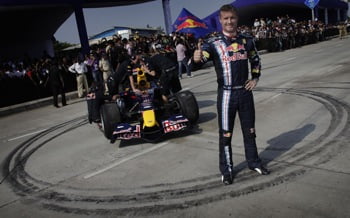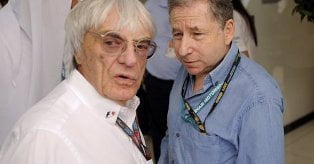Tony Fernandes, Caterham F1 Team Principal and aviation entrepreneur, touched upon a lesser spoken about topic a few weeks back when he discussed the sport of Formula1, its attitude and its marketing efforts to reach out to the newer audiences it attracted when it toured newer territories in Asia. This is one particular topic that I have been following personally and writing about for the past few seasons.
Before I proceed, here’s a little bit of how I understand the sport and setup of Formula1 and its primary markets. The sport of Formula1 has multiple stakeholders with different degrees of interests that they need to protect and project. The list of stakeholders starts from the FIA, FOM, FOTA, drivers, media, team’s sponsors and most importantly, the Formula1 fan! The list of interests too is varied and includes all the way from the brand of Formula1, to the various brands (teams, their sponsors, media, etc.) that invest in it. This list of course includes the fan who invests in the Formula1 viewing experience, whether it is on TV or in the stands.
If one were to read Fernandes’ statements on the sport, its attitude and marketing, you would agree that his biggest concern was for the ‘fan’, who has more often than not been neglected and treated as a ‘third world citizen’ (in my opinion). In the last decade, rules and regulations of the sport have witnessed multiple changes (both pre and during the seasons) that have left the fan much confused while dealing with the complexities of the changes. If you were to do a SWOT analysis of Formula1, one of the biggest weaknesses of the sport is that it is extremely complex, though it involves something as simple as ‘racing’, where the driver who finishes first, wins!
The changing economic conditions have led Formula1 to expand its base out of Europe. This is one of the main reasons why historic Grand Prixs like France have been left off the calendar while newer Grand Prixs have been introduced in Asian countries like Korea, India, Singapore and more. The logic is pretty simple; the newer countries are willing to pay Ecclestone a far higher race fee than the European countries that have their own debt related problems to solve. So while it makes complete business sense to take the sport to territories that are paying a higher price to host it, the sport’s marketing efforts too need to complement its business decision and be more focused to attract newer fans in those territories.
I have written about ‘Sports Marketing Around The Indian Grand Prix’ and this is the best example that I would like to cite. Much of the marketing efforts around the Indian Grand Prix were left in the hands of the teams and very little was undertaken by the sport itself. The teams were out promoting themselves and their sponsorship associations, so promoting the sport was never the primary objective. Considering that your product has entered a new market and territory and will attract new fans, Formula1 as a ‘brand’ should have indulged in marketing itself and not rely on the marketing activities of the teams alone.
The new fans that the Indian Grand Prix attracted to Formula1 would surely want to know more about DRS, KERS and the hundreds of other technical aspects of the sport. One must realize that Formula1 is not a natural sport in the new countries that it is visiting and hence the marketing efforts need to be far more to win the continuous attention and following of a fan.
The sport’s official website does explain much of the complexity that one would need an answer to. But going by my experience, direct promotions on TV, print and on-ground should have been undertaken to appeal to the Indian F1 fan. Most media activities and on-ground events were organized by the teams, sponsors and race organisers.
One could ask ‘what is wrong if the teams are undertaking all the marketing’? But one must realize that for the teams, the biggest challenge is to draw the thin line between marketing their brand and marketing Formula1. Given that the Formula1 eco-system has many layers, I would like the sport to speak for itself and establish a direct contact with its fans rather than rely on any of the teams or sponsors.
Maybe this is where there’s yet another lesson to be learned from the Indian Premier League? Read my earlier post: Formula1 Could Learn A Lesson From The Indian Premier League













6 comments On Formula1 Needs Better Marketing As It Enters Newer Territories
Formula one is not any more complicated that cricket , the concept of cricket and rules have been fed into our brains for decades their are rules and regulation changes in cricket also, even cricket has DRS (replay system) and thermal mapping , Marketing Formula 1 in India is like marketing cricket in USA , they won’t simple get the idea of the game , not a part of their culture , racing is a culture , and is quiet difficult to market it.
hi I am not certain Bernie is the slightest bit worried, concerned, or even interested in the attendance at any Formula 1 event . That is the worry of the particular franchisee holder. His concern is the tv audience. The new areas of growth will take a while to get a grips with this sport, many never will. Many countries are doing it for vanity, but it’s their choice, it’s their shop window to the world.
True Gareth and agreed that E isn’t most interested in the success of the event on-ground. But someday the circuits will come back to bite him if they are unable to attract the attention they need to sustain especially given the large hosting fees they part with. And sooner or later, once they’re done with window dressing and will worry about returns on investment, this model could well turn around and flop.
For a better marketing of F1 in INDIA – I think the famous F1 stars should start endorsing products in Indian media.
Say,
1)Vettel(stylish, determined & funny) for a FCUK watch
2)Alonso(sharp & tough) for Tata Land Rover
3)Hamilton(aggressive & reckless) – for UB group’s beer or something.He can bring in Nicole as well for extra punch.
4)Button(wit , safe driving) for revival of Maruti 800 🙂
Interesting ideas indeed. HAHA!
The real problem is that F1 was sold by Ecclestone with the help of ex FIA president Max Mosley, to a private equity firm (CVC) who kept Mr E on to work for them as a CEO.
Heres what they say on their web page:
cvc (dot) com/Our-Portfolio.htmx?ordertype=0&itemid=1431003124601
The new fans of the sport in new market and territories are low on CVC’s priority because their main aim is to get as much money out of the sport as possible for themselves and their investors and promotion and marketing in new market and territories will cost money that they don’t need to spend, as the franchisee holder makes money from Ticket sales, which is why it is expensive to buy a ticket to most GPs as the money is swallowed up by CVCs hosting fee.
CVC own the VIP hospitality and use this to their advantage. The air of exclusivity in the price means some people will pay high prices to be seen there particularly if the GP is new to a country, it is seen as a status symbol to be in the exclusive part of a big event. It’s also useful for entertaining CVCs own clients as well.
When it comes to paying for promotion of the sport in a new country/market CVC seems to be working with the fact that there are lots of countries queuing for GP, therefore when the franchisee holder (host of the GP be it Government or company paying for it) starts to question the return on the large amount of money they have paid, they are given the options:
1. To put up with it at least until the contract runs out and rely on their own marketing efforts and that of the cash strapped teams. (The teams rely on sponsorship from companies that have business interests across the world therefore it would be a requirement in the deals they make to do promotion and marketing)
2. cancel their existing contract (which will incur fines which will make CVC more money) leaving the door open for the next country to fill the gap.
This is the difference between F1 and the Indian Cricket Premier League. F1 is a sport that can have a race on any racetrack in pretty much any continent of the world (if the conditions are right to run a race to FIA safety standards) therefore CVC doesn’t have to rely on local fans, where as the IPL needs the core of its fans to be in India, meaning it is within the interests of the organisers of the IPL to promote Cricket heavily in its host nation as with any other national sports series, like the English Football Premier League or the any of the main American sports like NFL or NBA etc.
When it comes to global TV rights CVC relies on the core (mainly European) fan base, which is why most Asian race start times are mid-late afternoon or night races so they can televised in europe during the day or as close to “sociable hours” as possible.
IPL and occasionally the NFL and NBA are shown on TV here in the UK which could be seen as a new market territory for these sports but it is left up to the TV networks to do the promotion for such events as the UK isn’t the core market.
CVC works in the same way giving priority to certain Networks from its core market and then making extra money from other markets.
This may seem short a sighted business model but if and when countries governments and companies stop wanting to pay high prices to host F1 races CVC will simply sell the rights to F1 to the highest bidder. If the estimates of how revenue much is taken form F1 for each year is even a quarter true then selling at a loss will would still mean that a large amount of money has been made.